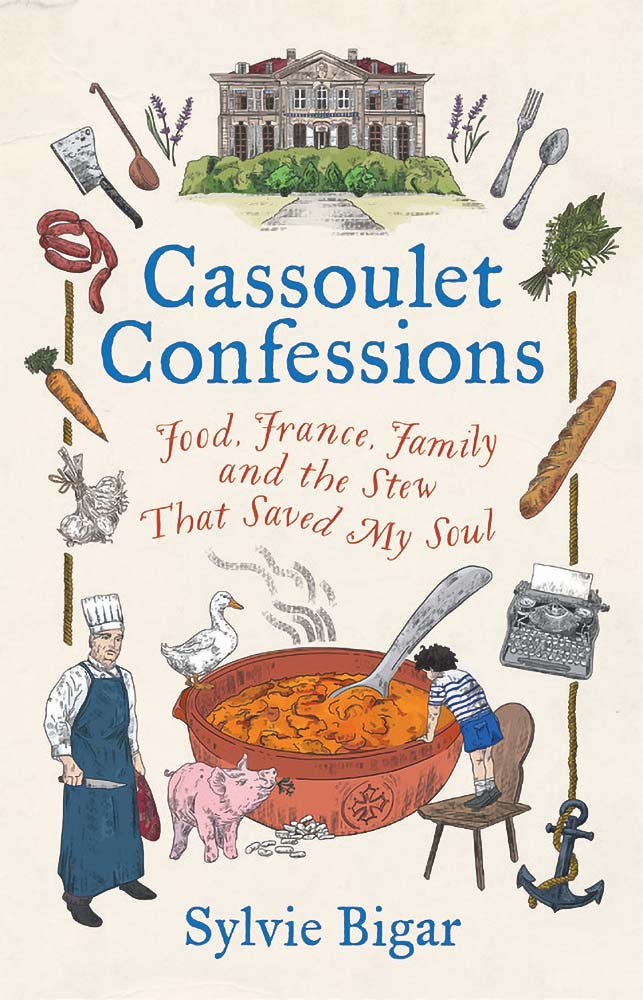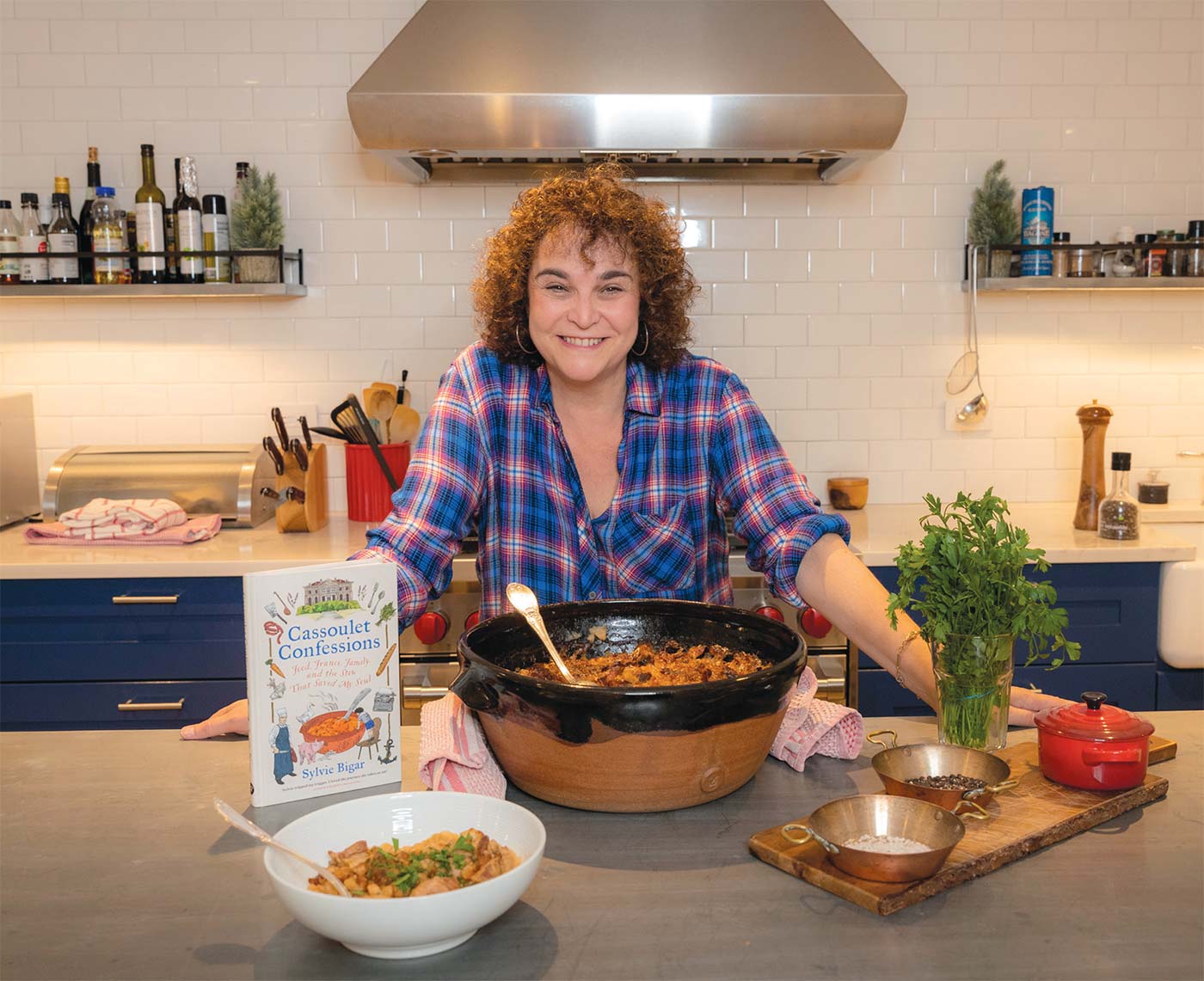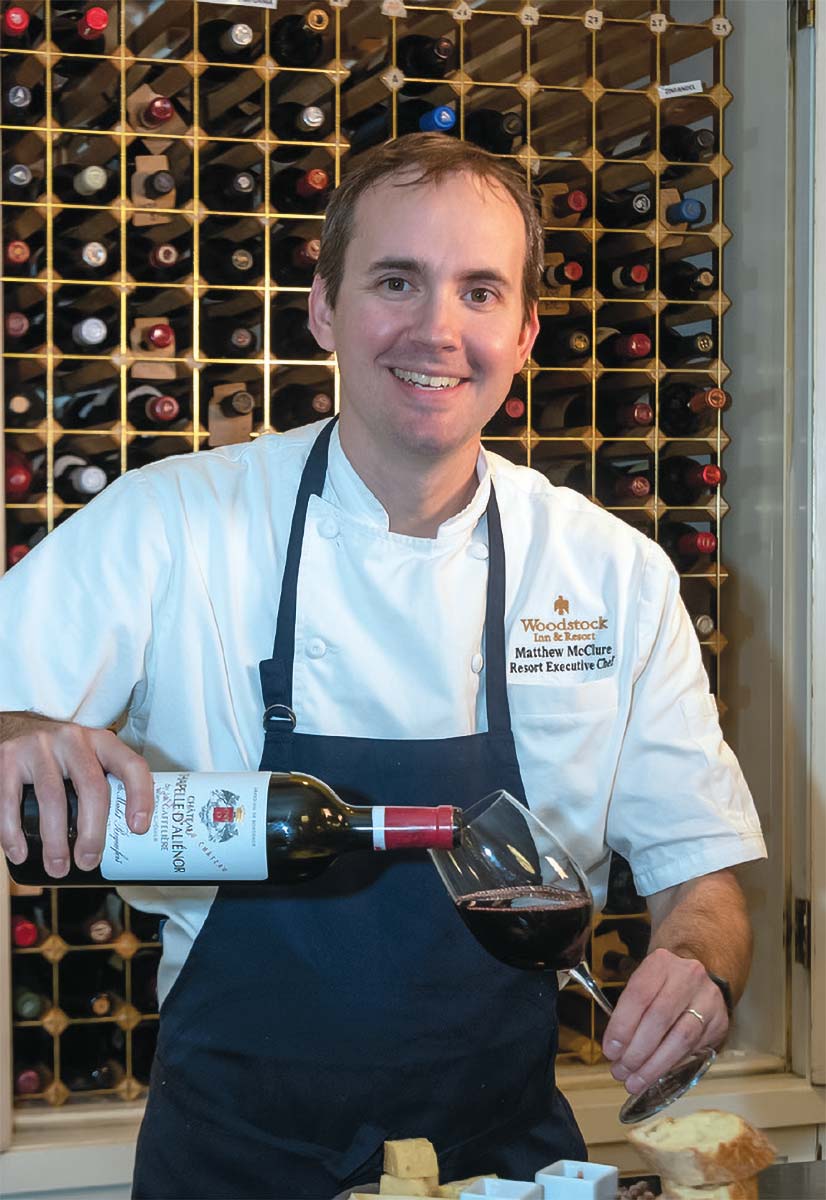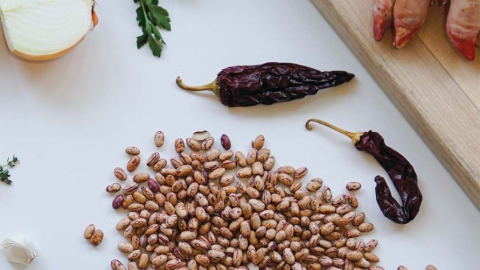Cassoulet Confessions:
 Written by Sylvie Bigar
Written by Sylvie Bigar
Published by Hardie Grant Books, 2022
Sylvie Bigar describes cassoulet as a “slow-cooked carnivorous orgy of pork, lamb, duck, beans, and herbs stewed together in an earthenware tureen.” When I read those words on page 3 of her book, I was hooked. Sylvie takes the reader on a journey through France, Switzerland, and New York as she weaves a beautifully crafted story that explores the origins of this stew while also unraveling the dish’s mysterious connection to her own family’s complex history.
I sat down with Sylvie and discussed how she came to be so obsessed by this seemingly humble dish.
Let’s begin with a quick introduction for those who may be less familiar.
Cassoulet is an ancestral dish, a poor man’s meal from southwestern France. Julia Child called it “baked beans with a French accent.” Every ingredient in that pot comes from the region. It sings of terroir, almost like a poem to the land.
Why does it make people swoon?
Cassoulet is a one-pot meal at the center of the table, and in Vermont’s cold, long winters, we crave these kinds of meals, whether it’s boeuf bourguignon or other rich soups or stews that braise or simmer in wine or stock with herbs. Everything infuses everything else, and when you take this dish out of the oven and put it on the table, you have a party.
For me, it's the process of planning, sourcing the ingredients, and just the anticipation of the final product that makes cassoulet the perfect winter weekend activity.
Absolutely. Here in Vermont, you have fabulous pork and duck and of course, the amazing Vermont Bean Crafters. And I understand that some people are intimidated by a dish like that because the real thing, as we know, takes three days. But in my book, I have this one recipe that we tested over and over again that I call Gateway Cassoulet. You can start in the morning and have your cassoulet at night. Who cares if you haven’t cooked your own stock for three days? Whet your appetite, try the dish, see how you like the mix of meats, and then maybe some other weekend, you’ll dig in to the three-day recipe.
What sparked your initial interest in the dish?
My editor of Food Arts magazine sent me to France in 2008 to come back with a 1,200-word article on cassoulet. I went back a year later to learn how to make authentic cassoulet; 10 years later, I couldn’t stop thinking about this thing. Then I realized there’s something deeper here. So I was lucky enough to take a little time off from my life and face the blank page. Typing what became the book’s first line, “We never ate cassoulet in Beau-Champ, my Swiss childhood home above Lake Geneva” suddenly allowed me to unravel what this obsession was about, which has nothing to do with cassoulet.

“Cassoulet is a one-pot meal at the center of the table, and in Vermont’s cold, long winters, we crave these kinds of meals, whether it’s boeuf bourguignon or other rich soups or stews that braise or simmer in wine or stock with herbs. Everything infuses everything else, and when you take this dish out of the oven and put it on the table, you have a party.” –Sylvie Bigar
This book is about so much more than a pot of richly flavored meats and aromatic beans. What unexpected twists and trails did it take you on personally?
Well, the book is called Cassoulet Confessions because it led me to face and confess my family’s history, some of which is pretty dramatic, including my father’s secret double life, my sister’s disabilities, and what it was like to grow up in a 36-room home on Lake Geneva. All the things that I ran from when I left my hometown of Geneva and settled in New York City, but you can’t really run from everything.
Okay. So tell us about the origins of this legendary dish.
Cassoulet dates back to the Middle Ages. According to legend, the town of Carcassonne was surrounded by the English during the Hundred Years’ War, and there was almost nothing left to eat. The mayor of Carcassonne told everybody to bring whatever they had in the cupboard—they would cook it together and have one last feast because this is France. Before you go to battle, you have one last feast. And they cooked down all of what they had, which was mainly beans and a little piece of pork here, a little piece of mutton there. They cooked everything together, and legend says that they were so empowered by this amazing dish they had just invented that they actually defeated the English and pushed them all the way back to the Channel. I don’t think it happened exactly like that, but everybody loved this story.
“Cassoulet dates back to the Middle Ages. According to legend, the town of Carcassonne was surrounded by the English during the Hundred Years’ War, and there was almost nothing left to eat. The mayor of Carcassonne told everybody to bring whatever they had in the cupboard—they would cook it together and have one last feast because this is France. Before you go to battle, you have one last feast.” –Sylvie Bigar
Are there essential elements that people agree about?
Well, everybody agrees with the beans. The problem is which beans because this being France, people fight and go to war over things like which beans to use. People usually agree on duck confit and pork sausage, onion, lots of garlic, and fresh herbs. My cassoulet mentor, Eric Garcia (not his real name; I have given him a pseudonym), always made a bouquet garni about a foot long. He would pick fresh herbs in the morning—thyme, rosemary, whatever he found in the mountains near his restaurant—then he would carve celery branches and roll them around the herbs like a real bouquet. A collagen-rich stock is also paramount, made with pork bones and skin. I actually devised a recipe that uses veal shank for people who don’t want to eat pork, and it worked really well.
How did you track down this chef who became your mentor?
I Googled cassoulet southwestern France, and I landed on the site of the Universal Academy of Cassoulet. That’s how I found Eric who cofounded that organization. Newsweek referred to him as the Pope of Cassoulet. He had a larger-than-life personality, kind of gruff, but was extremely kind and passionate about cooking.
Were there any moments when you were working alongside Eric where you felt like, what the heck have I gotten myself into?
Well, basically every time I was in the kitchen. I’m not a trained chef, I’m a writer. But I thought that in order to shake this crazy obsession, I would need to learn how to make authentic cassoulet. I had to convince him to allow me to intern in his restaurant. When I arrived, I walked into the kitchen and on the counter was this head of a pig, a knife, and a perfectly folded, starched white apron. Eric came in and saw me looking at the pig head and simply said, “You haven’t started yet.” That’s how he said hello.
And your adventures continued from there.
And they haven’t stopped yet!
“I thought that in order to shake this crazy obsession, I would need to learn how to make authentic cassoulet. ” –Sylvie Bigar
- Sylvie Bigar will be discussing her book with Maria Reade at Woodstock Inn & Resort on Thursday, January 18. This ticketed event includes a three-course meal centered on authentic cassoulet prepared from scratch by the inn’s executive chef Matthew McClure. To book, call 802-457-6609.
Chef Matthew McClure, Woodstock Inn & Resort
BY MARIA BUTEUX READE
 Although an Arkansas native, the Woodstock Inn & Resort’s executive chef Matthew McClure is no stranger to Vermont, having graduated from the New England Culinary Institute in Essex Junction in 2002. What drew him north from his home turf? “My dad was an avid outdoorsman so our refrigerator was always filled with wild game and fish. I loved cooking and realized I needed to go to culinary school to learn to cook at the high level I desired. NECI turned out to be the perfect choice for me, with its focus on fresh and local ingredients.”
Although an Arkansas native, the Woodstock Inn & Resort’s executive chef Matthew McClure is no stranger to Vermont, having graduated from the New England Culinary Institute in Essex Junction in 2002. What drew him north from his home turf? “My dad was an avid outdoorsman so our refrigerator was always filled with wild game and fish. I loved cooking and realized I needed to go to culinary school to learn to cook at the high level I desired. NECI turned out to be the perfect choice for me, with its focus on fresh and local ingredients.”
Matthew spent nearly 20 years running high-end restaurants in Little Rock and Bentonville, Arkansas. That’s where he was a James Beard Best Chef South semifinalist for six consecutive years. When a head hunter reached out to him in 2022 about a position at Woodstock Inn & Resort, Matthew and his wife jumped at the opportunity. “The inn felt like a perfect fit from a culinary standpoint because we truly celebrate ingredient-focused, seasonal cooking here. We love the food culture and vibe of Vermont, and I’m super excited to be back in the mix here! This winter, we’re learning to ski as a family at Saskadena Six just up the road.”
As a southerner who waxes rhapsodic about beans, cassoulet has become one of his favorite winter dishes. “I love recipes that require lots of steps. I prepare my own duck confit and pork sausage, and I soak the beans and make a three-day stock. The stock is luscious with collagen from the pork hocks and skin, and that gelatin develops the quintessential crust on the cassoulet. Cassoulet becomes a creamy vessel for whatever flavors I want to showcase.”
And to drink? “I usually go for an old-world, funky red. But a Vermont double IPA such as Second Fiddle is another excellent option.”
Seems like chef Matthew McClure and Woodstock Inn & Resort are indeed the perfect match!






